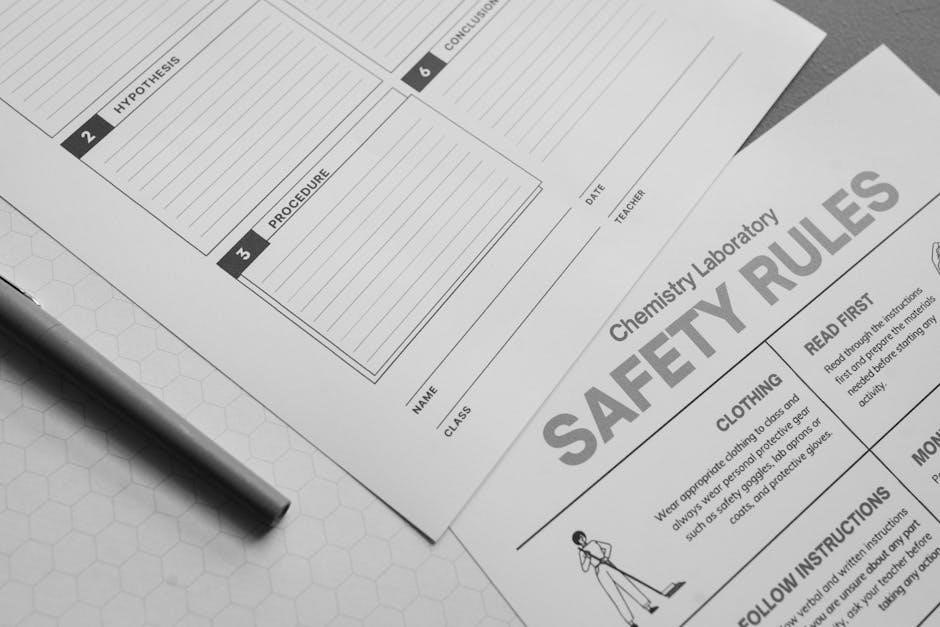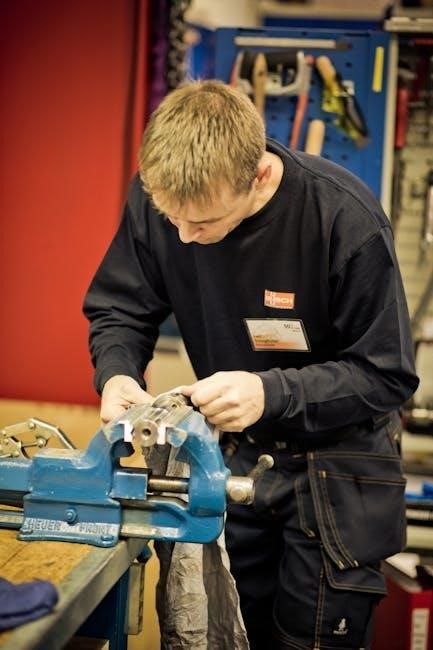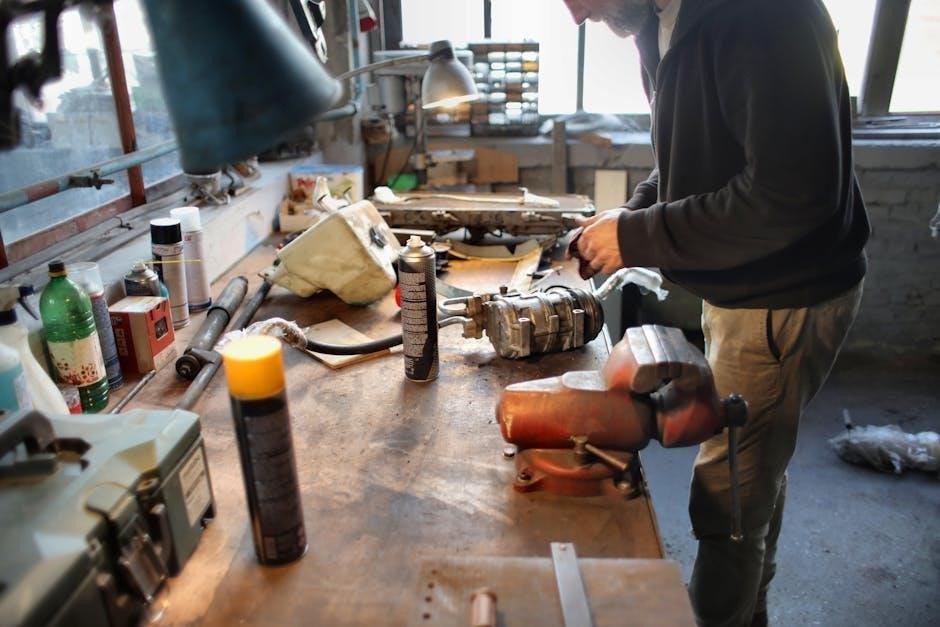Welcome to the comprehensive guide on using a TENS machine! This manual provides detailed instructions on operating your device safely and effectively. It covers setup, electrode placement, intensity adjustments, and maintenance, ensuring you achieve optimal pain relief. Follow these steps for successful TENS therapy.
Transcutaneous Electrical Nerve Stimulation (TENS) therapy is a non-invasive method used to relieve pain by delivering mild electrical impulses through the skin. These impulses stimulate nerve fibers, effectively blocking pain signals from reaching the brain. TENS units are compact, portable devices that offer a drug-free alternative for managing various types of pain.
The electrical pulses generated by the TENS machine can also encourage the body to produce endorphins, which are natural painkillers. This dual action of blocking pain signals and promoting endorphin release contributes to the overall pain relief experienced during TENS therapy.
TENS therapy is widely used for conditions such as lower back pain, shoulder pain, arthritis, and post-operative pain. It’s essential to understand the principles of TENS therapy to maximize its benefits and ensure safe usage. This manual will guide you through the proper techniques for applying TENS, including electrode placement, intensity adjustments, and safety precautions. By following these instructions, you can effectively manage your pain and improve your quality of life with TENS therapy.
Remember to consult with your healthcare provider before starting TENS therapy, especially if you have underlying medical conditions or are using other pain management methods.
Understanding TENS Unit Components
A typical TENS unit consists of several key components working together to deliver effective pain relief. The main component is the control unit, which houses the power source, usually batteries, and the electronic circuitry that generates the electrical pulses. This unit features adjustable controls for intensity, frequency, and pulse duration, allowing users to customize their treatment.
Electrode pads are another essential component. These adhesive pads are placed on the skin to transmit the electrical pulses to the targeted area. They come in various shapes and sizes to accommodate different body parts and pain locations. Connecting wires link the electrode pads to the control unit, carrying the electrical signals.
The user interface, typically a screen or a set of buttons, allows you to control the TENS unit. It is important to know how to use the controls and settings to adjust the intensity level, frequency, and pulse duration. Understanding each component’s role is crucial for effective TENS therapy. By familiarizing yourself with these parts, you can properly set up and operate your TENS unit for optimal pain management.
Always refer to the user manual for specific details about your TENS unit model.
Safety Precautions and Contraindications
Before using a TENS machine, it’s crucial to understand the necessary safety precautions and contraindications to prevent potential harm. Never apply electrode pads to the head, throat, or front of the neck. Avoid placing them on the eyes or chest, and never use TENS therapy over a pacemaker or implanted device. Ensure the device is off when applying or removing electrode pads.
TENS therapy is contraindicated for individuals with certain conditions. Do not use it over wounds, tumors, or areas with active skin infections. Pregnant women should consult their healthcare provider before using a TENS unit. People with epilepsy or heart conditions should also seek medical advice before starting TENS therapy.

Always start with the lowest intensity setting and gradually increase it to a comfortable level. Discontinue use if you experience any adverse reactions, such as skin irritation or muscle spasms. Keep the TENS unit out of reach of children and pets. Do not use while driving or operating heavy machinery.
Carefully read and follow the manufacturer’s instructions. If you have any doubts or concerns, consult your doctor or a qualified healthcare professional. Prioritizing safety ensures a positive and effective TENS therapy experience.
Preparing for TENS Treatment
Proper preparation is essential for a successful TENS treatment session. Begin by ensuring the TENS unit is turned off before you start applying the electrode pads. Gather all necessary supplies, including the TENS unit, electrode pads, connecting wires, and if needed, rubbing alcohol or skin cleansing wipes; Check that the TENS unit has sufficient battery power or is fully charged.
Next, clean the skin area where you intend to place the electrode pads. Use mild soap and water or rubbing alcohol to remove any oils, lotions, or dirt. Allow the skin to air dry completely before applying the pads. This step is crucial for ensuring good adhesion and effective electrical conductivity.
Inspect the electrode pads to make sure they are clean and in good condition. Replace pads that are worn out, damaged, or no longer sticky. Connect the electrode pads to the lead wires, ensuring a secure connection. Familiarize yourself with the TENS unit’s controls, including the intensity adjustment buttons and mode settings.
Plan the electrode pad placement based on your specific pain area, referring to the pad placement guide if needed. Create a comfortable and relaxing environment for your treatment session. By taking these preparatory steps, you’ll maximize the effectiveness and comfort of your TENS therapy.
Electrode Pad Placement Guide
Effective pain relief with a TENS unit heavily relies on correct electrode pad placement. The general principle is to surround the area of pain with the pads, ensuring the electrical current targets the affected nerves. Always refer to specific guidelines for different pain locations, but some universal rules apply.

Begin by identifying the precise location of your pain. Clean the skin thoroughly before application. Place pads at least one inch apart to prevent skin irritation and ensure proper current distribution. Experiment with different placements to find the most effective configuration for your specific condition. The goal is to bracket the pain area.
For linear pain, like along a nerve, place the pads along the nerve pathway. For localized pain, surround the painful spot. Avoid placing pads directly over bony prominences or open wounds. Ensure good contact between the pads and the skin for optimal conductivity. If using multiple channels, distribute the pads to cover the entire affected area.
Consider the direction of the current flow; it should pass through the painful region. If pain persists or worsens, adjust the pad placement slightly. The key is to find the configuration that provides the most significant pain relief without causing discomfort or skin irritation. Always consult healthcare professional.
General Pad Placement Guidelines
Proper pad placement is crucial for maximizing the effectiveness of your TENS unit. These guidelines will help you achieve optimal pain relief. Always start with clean, dry skin. Use soap and water or rubbing alcohol to remove oils and lotions from the treatment area. This ensures good adhesion and conductivity.
Never place pads directly on open wounds, irritated skin, or areas with poor sensation. Avoid bony prominences like the spine or elbows. Ensure at least one inch of space between pads to prevent current concentration and skin irritation. Experiment with pad arrangements to find what works best for you.
For localized pain, surround the area with pads. For radiating pain, place pads along the nerve pathway. If using two channels, crisscross the pads to intersect the pain zone. Observe your skin during and after treatment. If redness or irritation occurs, reposition the pads or reduce intensity. Always turn off the unit before adjusting pad placement.
Document successful placements for future reference. Consider using a skin protectant if you have sensitive skin. Remember, comfort is key. If a placement feels uncomfortable, adjust it. Consulting with a healthcare professional can provide personalized guidance for optimal pad placement based on your specific condition.
Pad Placement for Lower Back Pain
Lower back pain is a common ailment that TENS therapy can effectively address with correct pad placement. Before starting, ensure your skin is clean and dry. For general lower back pain, a common method involves placing two pads on either side of the spine, in the lumbar region, about an inch or two away from the spinal column. Position them horizontally or slightly angled, depending on where the pain is most intense.
Another approach involves placing one pad higher on the lower back and the other lower, targeting a broader area. If the pain radiates down the leg (sciatica), place one pad on the lower back and the other on the buttock or upper thigh, following the path of the sciatic nerve. Using two channels, crisscross the pads to intersect the pain area for more comprehensive coverage.

It’s often beneficial to have someone assist with pad placement, especially when reaching the lower back is difficult. Remember to keep the pads at least one inch apart. Start with the lowest intensity setting and gradually increase it until you feel a comfortable tingling sensation. Avoid placing pads directly on the spine or bony areas. Experiment with slight adjustments to find the most effective placement for your specific pain pattern. Discontinue use if any irritation develops.
Pad Placement for Shoulder Pain
Effective TENS therapy for shoulder pain hinges on precise electrode placement. Begin by identifying the specific area of pain – front, side, or back of the shoulder. For pain in the front of the shoulder, place one pad on the front deltoid muscle and another on the back of the shoulder blade (scapula). Ensure the pads are at least one inch apart.
If the pain is on the side of the shoulder, position the pads around the deltoid muscle, one slightly above and the other slightly below the painful area. For pain at the back of the shoulder, place one pad on the upper trapezius muscle and the other on the infraspinatus muscle, again maintaining the one-inch spacing.
When using two channels, consider a crisscross pattern to maximize coverage. Place one set of pads diagonally across the shoulder and the other set perpendicular to the first. This can be particularly helpful for broader pain areas. Always start with the lowest intensity setting and gradually increase until you feel a comfortable tingling sensation. Avoid placing pads on bony prominences or directly over joints. If you experience skin irritation, discontinue use and try hypoallergenic pads. Adjust the placement slightly if needed to target the pain most effectively.
Operating the TENS Machine
Operating your TENS machine effectively requires understanding its basic functions. First, ensure the device is switched off before connecting the electrode pads. Attach the lead wires to the pads and then firmly apply the pads to the pre-determined areas on your skin, ensuring good contact. Once the pads are securely in place, connect the lead wires to the TENS unit.
Turn on the device using the power button. Most TENS machines will start at the lowest intensity level. Gradually increase the intensity by using the adjustment buttons until you feel a comfortable tingling or buzzing sensation. Avoid setting the intensity too high, as it can cause muscle discomfort or skin irritation. If the sensation is too weak, increase the intensity slowly until you achieve the desired effect.
Select the appropriate mode based on your needs. Some machines offer continuous, burst, or modulated modes. Refer to the manufacturer’s instructions for detailed explanations of each mode. Treatment duration typically ranges from 15 to 60 minutes, depending on your condition and comfort level. After the session, turn off the device before removing the electrode pads.
Adjusting Intensity Levels
Adjusting the intensity levels on your TENS machine is crucial for effective pain relief. Begin by ensuring the device is switched off before applying the electrode pads to your skin. Once the pads are correctly placed, turn on the TENS unit. The intensity typically starts at the lowest setting. Gradually increase the intensity using the designated buttons or dials.
The goal is to find a level that provides a comfortable tingling or buzzing sensation without causing pain or muscle contractions. Increase the intensity slowly, paying close attention to your body’s response. If you feel any discomfort, immediately reduce the intensity. Some individuals may prefer a higher intensity for more noticeable relief, while others find lower levels more suitable.
Experiment with different intensity levels during your TENS therapy sessions to determine what works best for you. Remember, the ideal intensity is subjective and may vary depending on the area being treated and your individual pain threshold. Always prioritize comfort and avoid pushing the intensity to a point where it causes pain or discomfort.
Cleaning and Maintenance
Proper cleaning and maintenance are essential to prolong the life of your TENS machine and ensure its optimal performance. After each use, disconnect the electrode pads from the unit and gently wipe them clean with a slightly damp cloth or alcohol wipe. This removes any residue or oils that may have accumulated during treatment. Allow the pads to air dry completely before storing them.
The TENS unit itself can be cleaned with a soft, dry cloth. Avoid using excessive moisture or harsh chemicals, as these can damage the device. Inspect the lead wires regularly for any signs of wear or damage. Replace them if you notice fraying or exposed wires.
Store the TENS machine and its accessories in a cool, dry place away from direct sunlight and extreme temperatures. This helps prevent damage to the electronic components and ensures the pads maintain their adhesive properties. When not in use for extended periods, remove the batteries from the unit to prevent corrosion. Following these simple cleaning and maintenance tips will keep your TENS machine in excellent condition.

Troubleshooting Common Issues
Encountering issues with your TENS machine can be frustrating, but many problems can be resolved with simple troubleshooting steps. If the unit fails to power on, first check the batteries. Ensure they are correctly inserted and have sufficient charge. If using rechargeable batteries, verify they are fully charged.
If the TENS unit powers on but you don’t feel any stimulation, check the electrode pads. Make sure they are securely attached to your skin and properly connected to the lead wires. Replace the pads if they are dry, damaged, or no longer adhesive. Also, ensure the intensity level is appropriately adjusted.
If you experience inconsistent or weak stimulation, try cleaning the electrode pads and ensuring they are making good contact with your skin. Check the lead wires for any damage or loose connections. If the problem persists, try using a different set of electrode pads and lead wires.
If you experience skin irritation, try using hypoallergenic electrode pads or adjusting the pad placement. Reducing the intensity level can also help. If these steps don’t resolve the issue, consult your healthcare provider.
